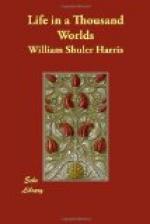The homes of Stazza are made of metallic substances. There are a few minerals very plentiful, resembling brass, and it is a common sight to see polished buildings fantastic in their arrangement, shining through the pellucid water like gold.
The cities are built on gentle inclines in the deeper waters and present a picturesque scene. They look more like a cluster of giant fairy abodes than like New York or London. Nothing in all the world of Stazza resembles a product of our manufacture more than the fine screening that protects every human dwelling from an invasion of small water animals. It reminded me of the mosquito netting as a safe-guard against flies and other insects in our world. But the mosquito baffles our genius, for he seems to be able to get through as small an opening as air can. Likewise, the pestiferous water animals seem to invade the homes of Stazza, notwithstanding all efforts at prevention.
The cities have no continuous streets or lanes. The principal travel is in the water over the city. The main entrance to the home is on the housetop. In the center of large buildings there is a shaft running up and down, through which the people go with greater ease than we can climb or descend our stairways. It must not be forgotten that water to them is the same as air to us, and in their domestic life the people are annoyed by cloudy and muddy currents of water just as we are by clouds of dust in the air, on the streets, or in our homes.
The wear and tear caused by the chemical action of water on houses and furniture is not as great as the injury in our world caused by the chemical action of air, heat and moisture.
The educational systems of Stazza are quite as perfect for that world as our own systems are for ours. They have an alphabet, covering their needs in language, consisting of a series of strokes, curves and angles, somewhat resembling our shorthand systems. This language is identical in print or script, and is superior to our method of expresssing thought by handwriting.
The experts of Stazza have learned the art of slicing metallic blocks into sheets of any desired thickness. These sheets serve the same purpose for them as paper does for us, and are furnished at an insignificant cost of labor. We have the very elements in our Earth to produce these metallic blocks if we knew the combination, which might be easily found if we had as much need for them as the people of this water world.
The metallic blocks are used for a great variety of purposes. There are some high class artists who have immortalized themselves by their master-pieces, one of which I saw on a five-cornered metallic sheet measuring about eight feet in diameter.
Perhaps the most surprising feature of the educational advancement of these water spirits is their knowledge of astronomy. To them, under the water, the stars have always looked beautiful, and from an early date in their history a study of them has engaged the attention of their scholars. No one could tell the style of their telescopes if he should go to guessing for a week. Let me give you a brief description of one.




